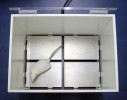Authors
S. Bouabid, C. Delaville, P. De Deurwaerdère, N. Lakhdar-Ghazal, A. Benazzouz
Lab
Institut des Maladies Neurodégénératives, Bordeaux, France
Journal
PLOS One
Abstract
Manganese neurotoxicity is associated with motor and cognitive disturbances known as Manganism. However, the mechanisms underlying these deficits remain unknown. Here we investigated the effects of manganese intoxication on motor and non-motor parkinsonian-like deficits such as locomotor activity, motor coordination, anxiety and “depressive-like” behaviors. Then, we studied the impact of this intoxication on the neuronal activity, the globus pallidus (GP) and subthalamic nucleus (STN). At the end of experiments, post-mortem tissue level of the three monoamines (dopamine, norepinephrine and serotonin) has been determined. The experiments were carried out in adult Sprague-Dawley rats, daily treated with MnCl2 (10 mg/kg/, i.p.) for 5 weeks. We show that manganese progressively reduced locomotor activity as well as motor coordination in parallel with the manifestation of anxiety and “depressive-like” behaviors. Electrophysiological results show that, while majority of GP and STN neurons discharged regularly in controls, manganese increased the number of GP and STN neurons discharging irregularly and/or with bursts. Biochemical results show that manganese significantly decreased tissue levels of norepinephrine and serotonin with increased metabolism of dopamine in the striatum. Our data provide evidence that manganese intoxication is associated with impaired neurotransmission of monoaminergic systems, which is at the origin of changes in basal ganglia neuronal activity and the manifestation of motor and non-motor deficits similar to those observed in atypical Parkinsonism.
BIOSEB Instruments Used:
Aron Test or Four Plates Test (LE830)

 Douleur - Allodynie/Hyperalgésie Thermique
Douleur - Allodynie/Hyperalgésie Thermique Douleur - Spontanée - Déficit de Posture
Douleur - Spontanée - Déficit de Posture Douleur - Allodynie/Hyperalgésie Mécanique
Douleur - Allodynie/Hyperalgésie Mécanique Apprentissage/Mémoire - Attention - Addiction
Apprentissage/Mémoire - Attention - Addiction Physiologie & Recherche Respiratoire
Physiologie & Recherche Respiratoire
 Douleur
Douleur Métabolisme
Métabolisme Système moteur
Système moteur Neurodégénérescence
Neurodégénérescence Thématiques transversales
Thématiques transversales Système musculaire
Système musculaire Functions de motricité générale
Functions de motricité générale Troubles de l'humeur
Troubles de l'humeur Other disorders
Other disorders Joints
Joints Système Nerveux Central (SNC)
Système Nerveux Central (SNC)
 Système sensoriel
Système sensoriel
